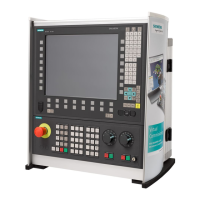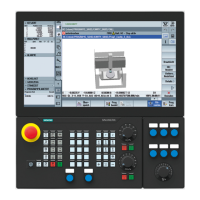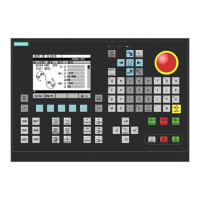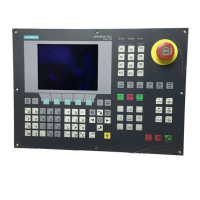Detailed Description
2.4 Frames
Axis Types, Coordinate Systems, Frames (K2)
Function Manual, 08/2005 Edition, 6FC5397-0BP10-0BA0
2-97
The ratios are shown in the figure below:
2ULJLQDOSRVLWLRQRIWKH
FRRUGLQDWHV\VWHP
2ULJLQDOSRVLWLRQRIWDEOH
3RVLWLRQRIWDEOH
DIWHUURWDWLRQ
3RVLWLRQRIFRRUGLQDWHV\VWHP
DIWHU7&$55
3RVLWLRQRIFRRUGLQDWHV\VWHP
DIWHU3$527
Fig. 2-25 Frame on activation of a rotary table with TCARR
With kinematics of type M (tool and table are each rotary around one axis), the activation of
a toolholder with TCARR simultaneously produces a corresponding change in the effective
tool length (if a tool is active) and the zero offset.
Rotations
Depending on the machining task, it is necessary to take into account not only a zero offset
(whether as frame or as tool length) when using a rotary toolholder or table, but also a
rotation. However, the activation of an orientational toolholder never leads directly to a
rotation of the coordinate system.
If only the tool can be rotated, a frame can be defined for it using TOFRAME or TOROT.
With rotary tables (kinematics types P and M), activation with TCARR similarly does not lead
to an immediate rotation of the coordinate system, i.e., even though the zero point of the
coordinate system is offset relative to the machine, while remaining fixed relative to the zero
point of the workpiece, the orientation remains unchanged in space.
If the coordinate system needs to be fixed relative to the workpiece, i.e., not only offset
relative to the original position but also rotated according to the rotation of the table, then
PAROT can be used to activate such a rotation in a similar manner to the situation with a
rotary tool.
With PAROT, the translations, scalings and mirroring in the active frame are retained, but the
rotation component is rotated by the rotation component of an orientational toolholder
corresponding to the table.
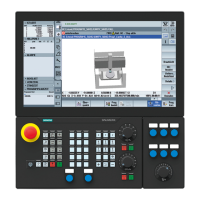
